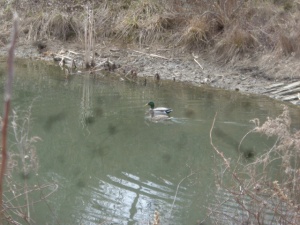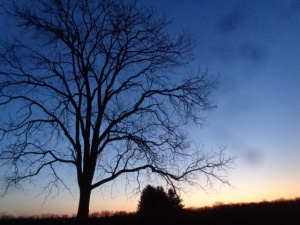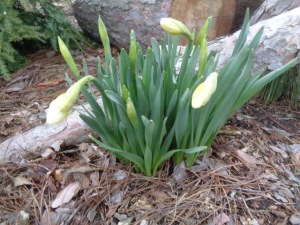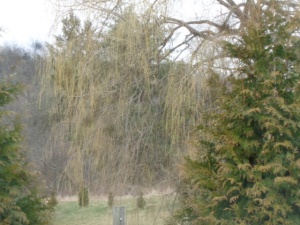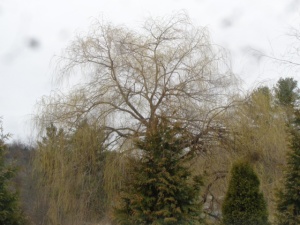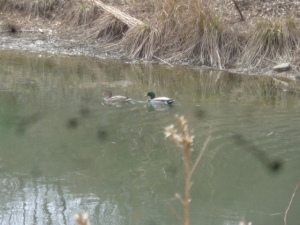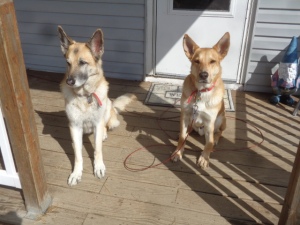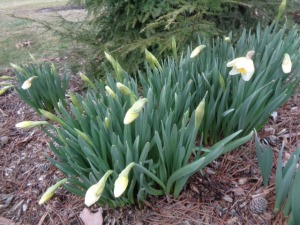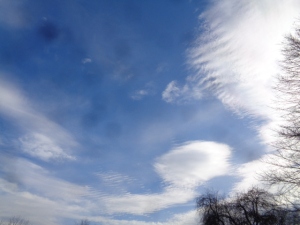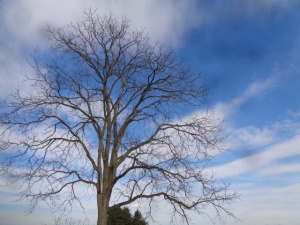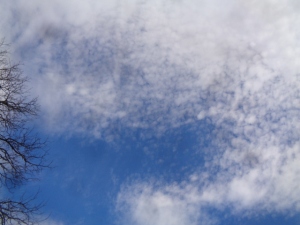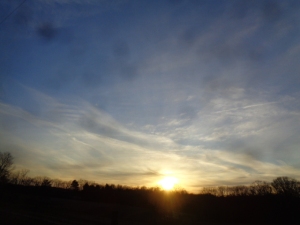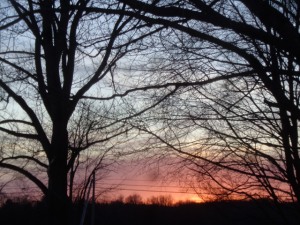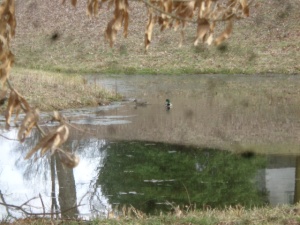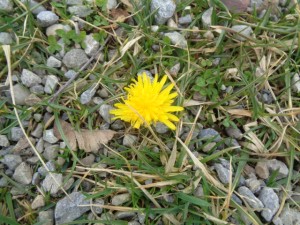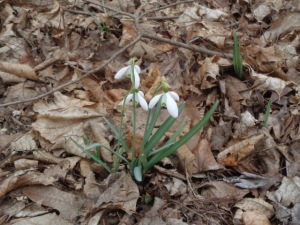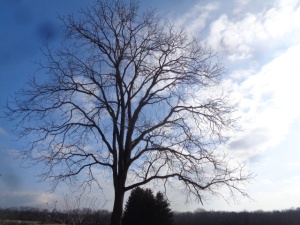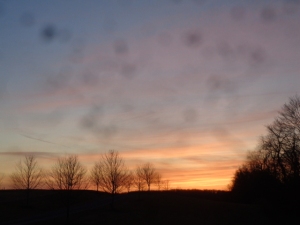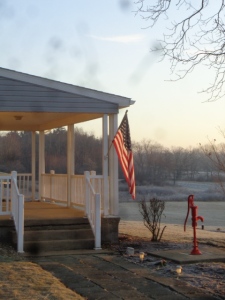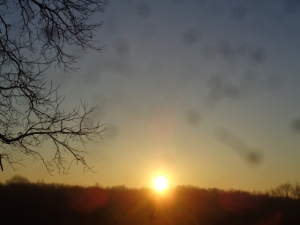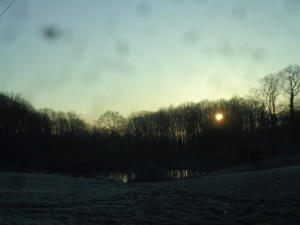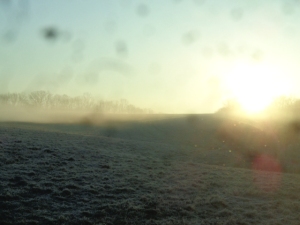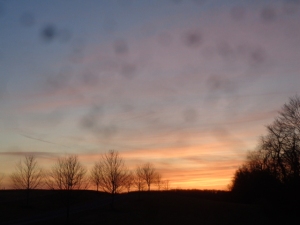
Crocus Amidst Daffodil Shoots and Grass Blades Lisa A. Wisniewski
Rain the past few days has made for some rather gray skies in our area. However, the rain combined with added daylight has allowed a number of dormant plants to come to life again. The result has been a hint of green in the woods and fields, along with a number of wildflowers and weeds emerging from the ground. This hint of green is a reminder that life is moving forward, despite the circumstances surrounding us. Sunshine late yesterday and earlier today provided a literal and figurative bright spot in our area. Sunrise is now at 7:14 AM and sunset is at 7:40 PM, allowing for extra evening activities.

Life Goes On Lisa A. Wisniewski
“In three words I can sum up what I have learned about life: it goes on.” -Robert Frost
Little By Little
The air temperatures remain cool, with highs in the upper 40°F range and lows in the 30°F range. Despite the cool evenings and chilly mornings, a number of bulbs continue to grow shoots from the ground. The daffodils and crocus are in bloom, but the tulips and hyacinth have yet to bud or flower. The slow but progressive growth of these bulbs is a reminder that even slow growth is progress. While the slowness of the process may be frustrating to us humans at times, we do eventually arrive where we need to be.

Day Lily Shoots Notice the Snail Hidden in the Shoots Lisa A. Wisniewski
The little by little approach is one way we learn. Think back to early grade school when you first learned to read. The teachers showed us how to read small words like the, and, ball, cat, dog, etc. Then we learned to read sentences with multiple words, like “See Jane run” or “The dog is brown.” After learning to read sentences, we graduated to paragraphs. Then on to short stories, and finally longer articles and books.
The plants grow little by little because of how they use nutrients provided. In a similar fashion, we humans grow physically, mentally, and emotionally as nutrients allow. These nutrients may be in the form of food, water, teaching, exercise, or some other manner. Like the plants, if we consume too much of any given nutrient, we become sick or stressed.

Nature’s Gold Lisa A. Wisniewski
“A man is rich in proportion to the number of things he can afford to let alone.” –Henry David Thoreau
One Step At a Time
The process that allows the plants to turn green (and other colors depending upon the plants’ pigment) is called photosynthesis. Photosynthesis is the changing of light energy to chemical energy. There are two types of photosynthesis: oxygenic and anoxygenic. The principles in each of these processes are similar, but oxygenic photosynthesis is more common as it is seen in plants, algae, and cyanobacteria.

Coreopsis Turning Green Lisa A. Wisniewski
During oxygenic photosynthesis, electrons from water are transferred to carbon dioxide to produce carbohydrates. The carbon dioxide is considered to be reduced, meaning it receives electrons. The water is oxidized, meaning it loses electrons. The oxidation of the water produces oxygen gas and hydrogen ions. The carbohydrates produced in green cells are starch and sugar sucrose.
Though photosynthesis can be neatly summarized as previously stated, the process involves numerous reactions involving enzymes, also known as organic catalysts. Catalysts increase the rate of reactions. Even though the rate of the reactions may be increased, the process still happens step by step, with no step being skipped.
The greening of the landscape this week has also been a process. Each day, another blade of grass, leaf shoot, or spring adds its own accent to the picture being painted by nature. As with both art and science, the additional colors are varied and unique to the plant types. Like any process, a number of aspects come together to create an output.

Setting Nature in Motion Lisa A. Wisniewski
“Vegetation is the basic instrument the creator uses to set all of nature in motion.” –Antoine Lavoisier
Help Along the Way
Photosynthesis is a process that depends upon a number of components. Some of the key components essential to photosynthesis include pigments and plastids. Pigments give color to plants, algae, and bacteria. Pigments also trap sunlight, and this trapping of the sunlight allows photosynthesis to occur.
There are three main groups of pigments: chlorophylls, carotenoids, and phycobilins. Chlorophylls are green pigments that trap blue and red light. Carotenoids are red, orange, or yellow pigments that absorb blueish green light. Phycobilins are red or blue pigments that trap other wavelengths of light that are not readily absorbed by chlorophylls or carotenoids.
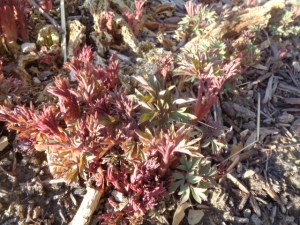
Pink Bleeding Heart Lisa A. Wisniewski
Plastids may contain pigments or store food. They reside in the cytoplasm of plant cells. Like many things in life and nature, there are different types of plastids. Chloroplasts are plastids that contain green pigment. Plastids containing pigments other than green are called chromoplasts. A leucoplast is a plastid that lacks pigment. A proplastid is a plastid with no differentiation the may later develop into one of the other types of plastids.
All of these components are essential to photosynthesis. Like the many members of the human body, these elements act as required to complete the overall function. No one member is more important than another member, for all are necessary at given points in the process.

White Bleeding Heart Lisa A. Wisniewski
“Every particular in nature, a leaf, a drop, a crystal, a moment of time is related to the whole, and partakes of the perfection of the whole.” –Ralph Waldo Emerson
Beauty Seen and Unseen
In our walks this week, we found a number of green plants, including thistle, fleabane, iris, violets, day lilies, gil-over-the-ground, and henbit. The henbit was the most interesting, with its deep green textured leaves and pinkish-purple flowers. The thistle was a bit of a reminder to the coming onslaught of “weeds” we will be pulling from the driveway and landscape beds.

Thistle Lisa A. Wisniewski
Seeing the thistle made me wonder why nature created such plants. The green part of the plant is interesting and has a beauty of its own, but those little prickly hairs that can pinch and puncture skin can be a nuisance. Considering all the thistle has to offer reminded me that nature creates all things for a reason. We may not understand this reason on earth, but possibly that is the point—not to understand, but to ponder, wonder, and eventually accept it for what it is.
Reflecting on this a bit longer reminded me of a favorite song that speaks of roses and thorns. Though the song was recorded a number of years ago, it does fit the times we see currently in the world and offers a different perspective to the power and frailty of life itself.
God Is In The Roses

Thorns After the Rain Lisa A. Wisniewski
God is in the roses
The petals and the thorns
Storms out on the oceans
The souls who will be born
And every drop of rain that falls
Falls for those who mourn
God is in the roses and the thorns
The sun is on the cemetery
Leaves are on the stones
There never was a place on earth
That felt so much like home
We’re falling like the velvet petals
We’re bleeding and we’re torn
But God is in the roses and the thorns

Never Will Be Done Lisa A. Wisniewski
I love you like a brother
A father and a son
It may not last forever and ever
But it never will be done
My whole world fits inside the moment
I saw you be reborn
God is in the roses
And that day was filled with roses
God is in the roses and the thorns
(Written by Rosanne Cash after the death of her father, Johnny Cash)
As the lyrics state, we are much like the petals of a flower, but have our own thorns. Both were created by God, and if we look hard enough, we can see Him in these and other aspects of our lives. Like the green growth of spring, we too go through times of different colors in the seasons of our lives. We inch along through the miles with the help of others. It is when we learn to understand that we see the flower full of beauty. This understanding requires patience, hope, faith, love, and a myriad of other inputs to produce the bloom.
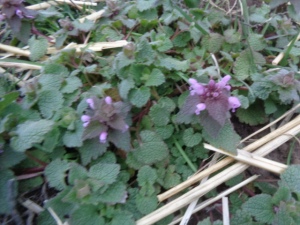
Henbit Lisa A. Wisniewski
“The Amen of nature is always a flower.” –Oliver Wendell Holmes, Sr.
May the days we encounter along our journey allow us to grow. May this growth in turn allow us to share what we have with others, furthering along the growth of all, and may we find our way to where we need to be through the inching of the green.

Shoots Emerge Lisa A. Wisniewski
Inching of the Green
Little by little the shoots emerge
From the brittle seeds and bulbs under the earth,
Each one granted a life line
By the sun, wind, and rains of time
All to be taken in and absorbed
So that what has been is no more,
Converting light energy to growth
So that what is to come to be is made known
Through the inching of the green
As it moves onward in time’s sea.

Step By Step Lisa A. Wisniewski
Step by step along the way
The shoots beget flowers that sway
In the breeze and let their pollen fly
To feed the bees and birds in the sky
Who then take it from plant to plant
To replenish on earth what man can’t
Keeping the process of life sustained
Through the blessings of God’s grace
And the inching of the green
Minting life eternally.

Viola Lisa A. Wisniewski
Through the shoots and blades, springs and leaves
Life comes to after winter’s sleep
Sending energy forth
In the sun’s beams and rains’ force
To the earth below
Dispelling the dearth and casting a rainbow
Just like the covenant in Scriptures describe
Between the heavens and human life
Carried forth in the inching of the green
Allowing life’s storms to be washed out to sea.
-Lisa A. Wisniewski

Ever Evolving Lisa A. Wisniewski
A Note of Thanks

Bo in 2012 Lisa A. Wisniewski
Our thanks this week goes out to my late dog, Bo, who passed away March 25, 2013, shortly before his second birthday. Though Bo’s time on earth was short and his journey rather difficult, he managed to teach me many lessons. One of these lessons was that sometimes in life, you have to recognize your limitations and inch your way along to new growth. You can read more about Bo in the book Trouble With a Capital LU-K-E. We would also like to thank the people in our community who have reached out to make sure we are managing through what most of the country and world are viewing as difficult times. Our hope and our faith tell us we will survive, as will many others. Like the photosynthesis process, it will take the work of many working together to get us through.

Editor-in-Chief Sadie and Junior Editor Leo Lisa A. Wisniewski
We celebrate this week the fifth year of posting on Natural Deltas. This blog started out as a requirement for a graduate class and has since evolved into the format seen today. We have made 280 posts and gained followers across the globe and country. We thank the many people who have read our posts through the years and we remain committed to posting quality writing that in the words of Joseph Pulitzer, “Put it before them briefly so they will read it, clearly so they will appreciate it, picturesquely so they will remember it and, above all, accurately so they will be guided by its light.”
-Lisa, Sadie, and Leo


